We've Turned the Planet Into A Gigantic Toxic Chemical Spill — With Serious Implications for Global Health
We're exposed to literally THOUSANDS of chemicals — carcinogens, neurotoxins, and endocrine-disrupting agents — that our ancestors just 100 years ago would've never encountered. This is ... not good.
Consistent with my pledge to cover more than just AI — although additional articles on AI are forthcoming, including one that offers a comprehensive mapping of Silicon Valley pro-extinctionist views! — here’s a piece on environmental toxins. I hope you find it interesting. :-)
Your body, right now, almost certainly contains hundreds or thousands of chemicals that people just ~100 years ago would have literally never encountered during their entire lifetimes — because, in most cases, these chemicals hadn’t yet been invented.
The contemporary world is a swirling soup of carcinogens, neurotoxins, and endocrine-disrupting chemicals. A large percentage of these haven’t even been safety tested, while others are known to damage certain organs in our bodies, including our brains. This leads me to be no less worried about the decline of biological intelligence as I am about the rise of artificial intelligence.1 Everyone’s talking about the latter right now, and my sense is that most people aren’t really aware of the former.
What follows is a brief overview of chemicals that have become pervasive in our environment. This is far from exhaustive, but I hope it gives readers a sense of — in my opinion — just how dire the situation has become. To paraphrase one scholar, the human brain is the only organ in the body that poses a direct threat to itself.
§
Let’s begin our exploration with a quote from an article that I recently published, which I’ll draw from below:
There is mercury in fish, cadmium in chocolate bars, lead in wine and alcohol, organophosphates on fruits and vegetables, phthalates in our food, volatile organic compounds (VOCs) in household products, and BPS in store receipts.
Mercury, cadmium, and lead are heavy metals with neurotoxic properties. Lead, for example, causes irreversible brain damage by destroying the myelin sheaths that envelop the axons of neurons (brain cells), thereby significantly slowing down the propagation of information from one neuron to another, as well as by reducing the total number of neurons contained in our skulls. According to UNICEF, upwards of 800 million children — about a third of all the children on Earth — have some form of lead poisoning(!). To be clear, that’s nearly a billion kids who will suffer the effects of brain damage for the rest of their lives.
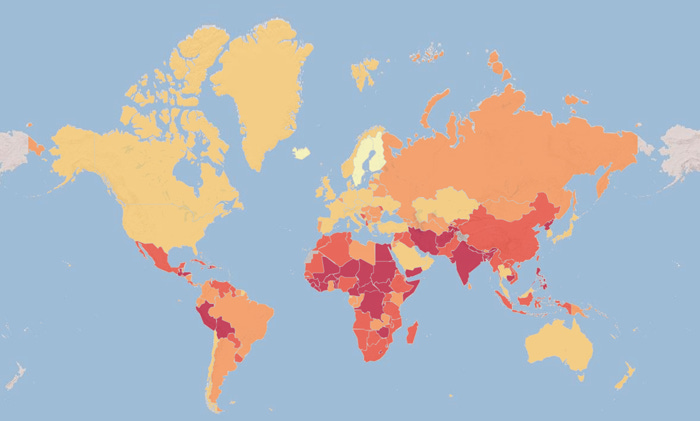
Another study reports that “over 170 million Americans alive today were exposed to high-lead levels in early childhood, several million of whom were exposed to five-plus times the current reference level.” This is about half the entire US population, as of 2022.
It’s not just children who are vulnerable: adults are susceptible to the adverse effects of lead by simply breathing in dust that contains the metal. Most soil near highways is contaminated with lead due to lead having been added to gasoline, which the US banned in 1979, and growing underground plants like carrots can contaminate food, too. Even just walking through a neighborhood with houses that have peeling lead paint on a breezy day can result in exposure.
According to a University of Virginia study, the “bullseye” for lead exposure is Gen X, which is why some describe it as the “lead generation.” A coauthor of the study says that they “estimate that at least 151 million cases of diagnosable mental disorder that the population would have experienced over the last 75 years could be attributable to lead.” There also appears to be a connection between lead and crime rates: reducing lead exposure results in the crime rate falling.
§
Worldwide, exposure to another heavy metal — arsenic — has poisoned 140 million people. This can also significantly affect the development of young brains. The CDC states that in the US “the main source of arsenic exposure is via ingestion of food containing arsenic,” although water can also be an exposure route. As one paper notes, “long-standing exposure, through industrial hazards and consumption of arsenic-contaminated water, [has] severe health impacts in humans, which mainly target the nervous system.” Here’s a map of arsenic exposure through water in the US:
The region in which I currently live — northern Ohio — is shaded orange, indicating relatively high levels of arsenic in the water. This also happens to fall within the so-called “Parkinson’s Belt,” an area marked by anomalously high rates of Parkinson’s disease, probably due to industrial contaminants, given that the Parkinson’s Belt overlaps with the Rust Belt. Zooming out, studies show that the prevalence of Parkinson’s has more than doubled over the past 25 years and is projected to “surge” by 2050. This isn’t the only neurodegenerative disease that’s on the rise, as we’ll see below.
§
Yet another study finds that a stunning 97% of Americans have PFAS in their bodies. “PFAS” are also called “forever chemicals” because they are “the most persistent synthetic chemicals to date,” lingering in the environment for literally thousands of years (or 40+ human generations). Exposure to even small amounts of PFAS has been linked to “a wide variety of health problems, including kidney and testicular cancer, liver problems, high cholesterol, and immunosuppression.” Here’s a great piece on PFAS from John Oliver:
Perhaps the prevalence of PFAS — along with heavy metals, organophosphates, and microplastics (discussed below) — has something to do with the fact that the “global incidence of early-onset cancer increased by 79.1% and the number of early-onset cancer deaths increased by 27.7% between 1990 and 2019,” based on an analysis that includes 29 types of cancer.2
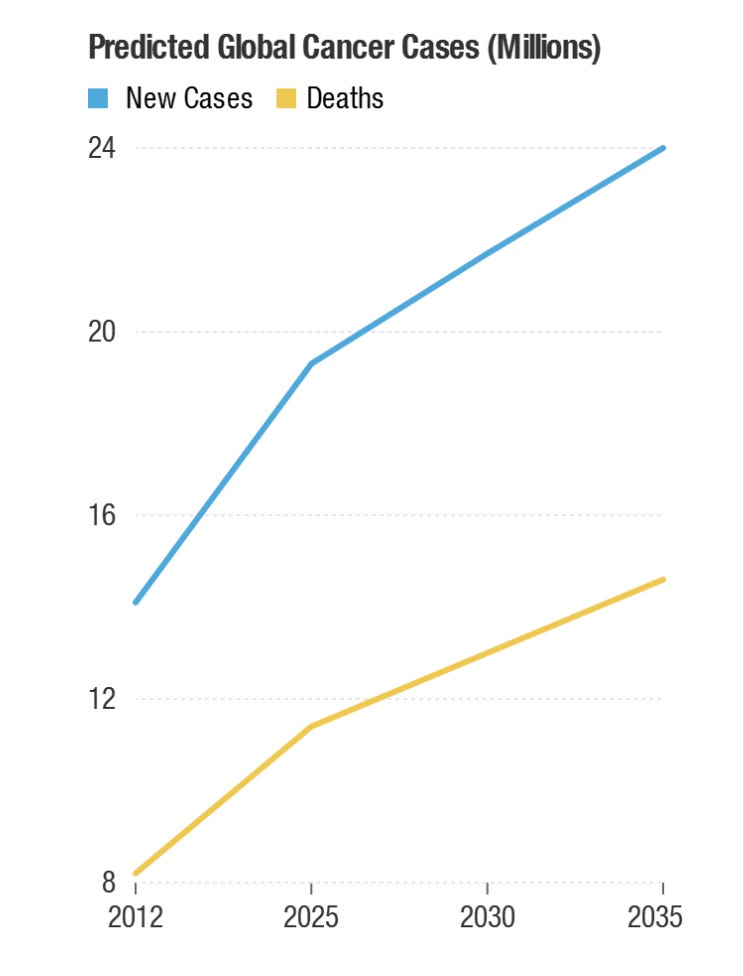
According to one account, “since the 1950s, many products commonly used by consumers and industry have been manufactured with or from PFAS.” Another reports that “ocean waves crashing on the world’s shores emit more PFAS into the air than the world’s industrial polluters … The contaminated spray likely affects groundwater, surface water, vegetation, and agricultural products near coastlines that are far from industrial sources of PFAS.” So, you know, enjoy that vacation at the beach!
§
Another substance that’s become environmentally ubiquitous is microplastics. These can infiltrate every organ in the body, including the brain, causing “oxidative stress, DNA damage, organ dysfunction, metabolic disorder, immune response, neurotoxicity, as well as reproductive and developmental toxicity.” Microplastics are found in both bottled water and tap water, meaning that there’s no way to escape them, and it’s been widely reported that about 0.5% of our brains (by weight) are now made of plastic. As a Smithsonian article puts it:
The human brain may contain up to a spoon’s worth of tiny plastic shards—not a spoonful, but the same weight (about seven grams) as a plastic spoon, according to new findings published … in the journal Nature Medicine. … Based on their analysis, the amount of microplastics in the human brain appears to be increasing over time: Concentrations rose by roughly 50 percent between 2016 and 2024.
I shared this study with my dad, who has a good sense of humor. His retort: “Surely this is a good thing, because it means greater brain plasticity.” LOL.
Other studies have identified trace amounts of antipsychotics, sex hormones, tranquilizers, and antibiotics in public water systems. The amounts present are typically far below levels considered safe, but no one has studied (a) the potential effects of long-term, low-dose exposure, and (b) the possible interactions between all the different chemicals in our bodies and brains. How might small amounts of antipsychotics, tranquilizers, PFAS, microplastics, lead, arsenic, organophosphates, phthalates, BPS, etc. interact with each other? Could there be additive or synergistic effects that amplify the harms? No one knows, though we will find out in the coming decades.
§
Another issue concerns the effect of air pollution on our brains. One study from 2022 reports that exposure to pollution causes appreciable declines in test scores among students, and the effects on performance may be irreversible. As the authors write,
children who move to a school downwind of a major highway have lower test scores and a higher likelihood of behavioral incidents and missing school than when those same children attended schools with similar characteristics that were not downwind of a major highway. The effects are larger for more heavily-trafficked roads, and the effects appear to last even after the child moves away from a downwind school. This suggests that once damage from pollution is done, even during middle childhood, it might persist, potentially affecting outcomes far into the future.
Black communities in the US are especially vulnerable, as Black neighborhoods are often located close to or downwind from sources of air pollution. For example, a study published last year found that
Black Americans are significantly more likely to die from causes related to air pollution, compared with other racial and ethnic groups. They face a double jeopardy: more exposure to polluted air along with more susceptibility to its adverse health effects because of societal disadvantages.
Globally, about 6.7 million people die prematurely each year due to air pollution from both outdoor and indoor sources. With respect to the latter, household items like paints, aerosol sprays, cleaners and disinfectants, dry-cleaned clothing, and pesticides can produce pollutants (such as VOCs, or volatile organic compounds). There’s even a term for residents becoming ill from indoor pollution: “sick building syndrome.” Without fresh air, such contaminants can accumulate over time, so keep a window cracked throughout the year and consider buying an air purifier!
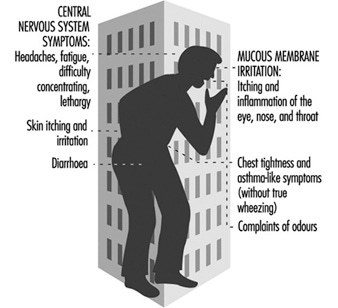
Another molecule that can accumulate indoors is carbon dioxide (CO2), which can easily reach levels of 2,000 parts per million (ppm) or higher. High levels of CO2 can cause significant — albeit reversible — declines in cognitive performance. This is yet another reason to keep a window cracked, although of course we can’t escape rising CO2 levels in the ambient atmosphere due to burning fossil fuels. Given the rise of atmospheric CO2, an article in Yale Climate Connection concludes that climate change is quite literally making everyone “dumber.” The atmosphere currently contains about 425 ppm of CO2, and this CO2 will “linger for millennia” even if civilization were to go carbon-neutral next week.
To put this in perspective, our Paleolithic ancestors lived in an environment with about 280 ppm, significantly lower than current levels. You and I will never know what it’s like to breathe air with that CO2 concentration!
§
This is one big mess — the entire planet is now a gigantic chemical spill zone — and we’ve not even mentioned the cognitive harms of things like sleep deprivation, chronic stress, and loneliness, which affect a large percentage of the US population. Even endocrine-disrupting chemicals, found in everything from shampoos and cosmetics to children’s toys and baby bottles, can negatively impact our brains. There are also reports from earlier this year of “brain-harming chemicals” being “released from mattresses while children sleep,” with a separate study finding 34 dangerous chemicals detected in over 90% of all children, “including nine chemicals not currently tracked in national health surveys.” As the study’s lead author says,
our study shows that childhood exposure to potentially harmful chemicals is widespread. This is alarming because we know early childhood is a critical window for brain and body development.
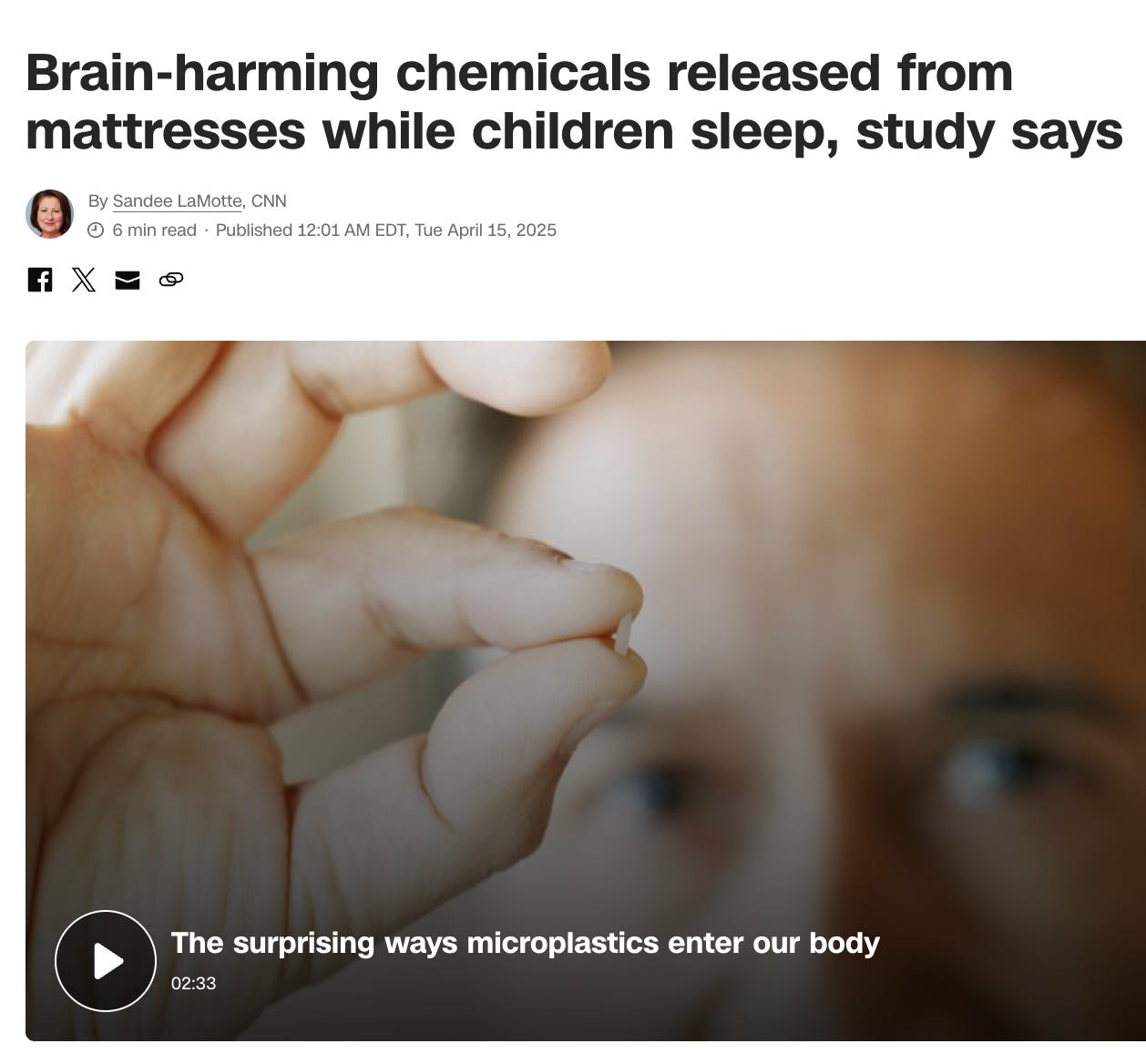
Nor have we discussed yet another disconcerting link between global warming and cognitive impairment: wildfires, which produce smoke that’s linked to dementia. As more people are exposed to wildfires around the world, rates of dementia will rise even further. As of 2020, there were over 55 million people suffering from this condition, with 78 million being projected by 2030 and 139 by 2050. In fact, the prevalence of early-onset dementia is rapidly increasing, with a 131% rise in Alzheimer’s diagnoses between 2013 and 2017 alone. This isn’t because people are living longer: folks under the age of 65 are increasingly susceptible.
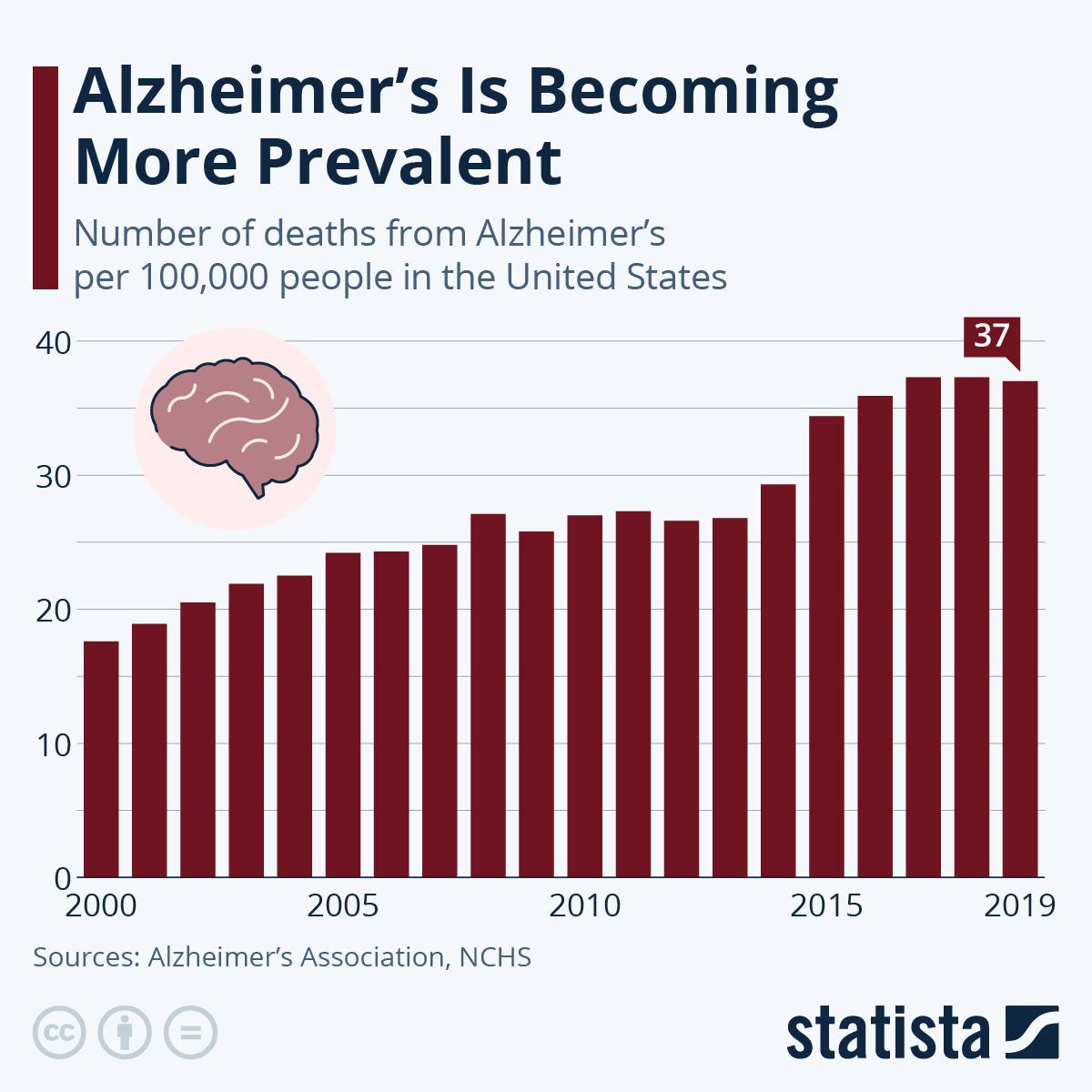
We have, inadvertently, created a global experiment that’s being conducted in realtime. Yes, we should worry about the rise of AI, but we should also be concerned about the decline of BI — that is, biological intelligence. What are the long-term implications of the constant chemical assaults on our bodies and brains? How might the ubiquity of neurotoxins, endocrine-disruptors, etc. increase the probability of outcomes like civilizational collapse? After all, humanity is facing unprecedented — in terms of scale, magnitude, and complexity — problems like climate change. We’re up against what scholars now call the “polycrisis.”
If our brains can’t function properly because of chemical contaminants constantly zapping our neurons, to what extent might this impede our collective ability to solve these problems? Might there even be some connection here with the so-called “dumbing down” of America and the reelection of Donald Trump? After all, Kamala Harris won most voters under 30 and tied with Trump among over-65 voters. But Gen X — the lead generation! — “gave Trump a ten-point margin,” thus “deliver[ing] the presidential election” to this deeply anti-intellectual fascist. I don’t have an answer here, but it does raise an eyebrow!
§
What can we do about this? I have nothing more than obvious suggestions: eliminate peeling lead paint on your house. Filter your tap water. Avoid plastics as much as you can. Buy an air filter for your home. Limit your consumption of fish. Etc. Perhaps we need a 21st-century Rachel Carson to sound the alarm the way she did about synthetic pesticides like DDT in the 1960s. As I write in my book Human Extinction: A History of the Science and Ethics of Annihilation:
By far the most significant contribution to modern environmentalism was the 1962 book Silent Spring by Rachel Carson, described by a New York Times article as having “influenced the environmental movement as no one had since the 19th century’s most celebrated hermit, Henry David Thoreau, wrote about Walden Pond.” So impactful was Carson’s publication that it inspired the creation of the US Environmental Protection Agency (EPA) in 1970, and “prompted the Federal Government to take action against water and air pollution—as well as against the misuse of pesticides—several years before it otherwise might have moved,” to quote the EPA’s official history website.
The present post, then, could be seen as a hastily-written abstract for the book that someone needs to write — someone capable of catapulting the issue into the public consciousness and turning it into a priority for our government. I am genuinely alarmed by the pervasiveness of toxic chemicals in our surroundings. The frightening fact is that it’s almost impossible to go anywhere on Earth these days and not get poisoned. Yet, stressing out about this fact is counterproductive, as chronic stress itself can be toxic to our bodies and brains!
I’m very curious what you think about all of this. What am I missing? How are you avoiding microplastics and PFAS? Any good strategies to share?
Thanks so much for reading and I’ll see you on the other side!
Acknowledgements: Thanks to Devin Kellis and Keira Havens (who has never liked eugenics or authoritarians and now leads Citizens’ Impeachment). Their feedback was invaluable and insightful; any remaining errors are my own!
Note that talk of “biological intelligence” does not in any way commit one to the idea of “IQ” or “general intelligence” (the g factor). I strongly reject the idea of “general intelligence” as a quantifiable property measurable by IQ tests, as I find this reductionist view deeply problematic. I’ll explain the details in a subsequent post, but for now consider a silly analogy: most of us aren’t skeptics about beauty. We might agree that some, e.g., works of art or natural landscapes really are beautiful. However, most would also say that there’s no single, linear, one-dimensional scale of beauty according to which everything in the world can be ranked. There are a million different ways for something to be beautiful. Hence: Is Michelangelo’s “David” more beautiful than van Gogh’s “Starry Night”? I have no idea how to answer that, even though I’d affirm that both are beautiful, in their own particular ways. Similarly, was Albert Einstein more intelligent than, Ludwig Wittgenstein or Judith Butler? What about Kurt Cobain or Mozart? These questions are nonsensical, because they assume a fundamentally incorrect conception of “intelligence.” So, you can believe that biological intelligence is real while simultaneously rejecting the idea of IQ and “general intelligence.”
Italics added.


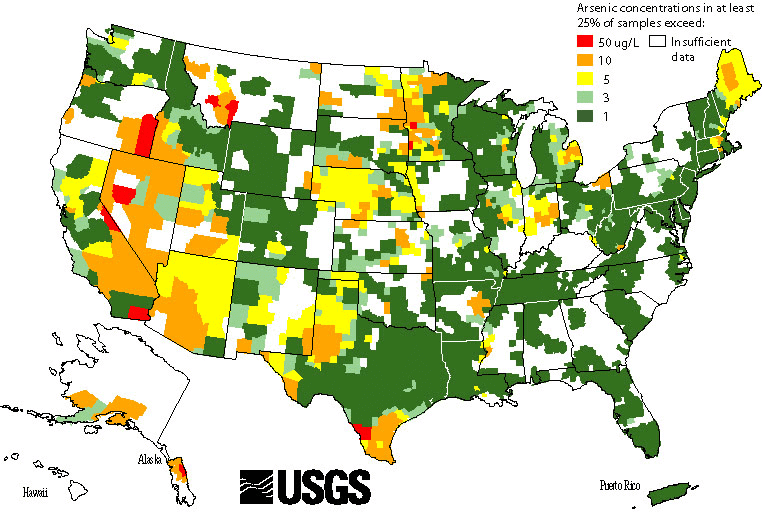
This is a great article!
You made a distinction between this article about chemical spills from machine industries, and your other articles about AI harms.
These two topics are intimately tied for me. Artificial industries are scaled up to extract while spilling toxins – at the detriment of our health.
But these industries can operate and scale without us being healthy. If some human workers get sick, technology corporations can swap them out with other workers. Our organic needs would have to be met less and less as industries robotise, and throw out the human workers.
The common thread is a gradual decoupling of the artificial industries (that need artificial chemical processes and conditions to be maintained and scaled) from what our organic ecosystem and communities living within need to thrive and survive.